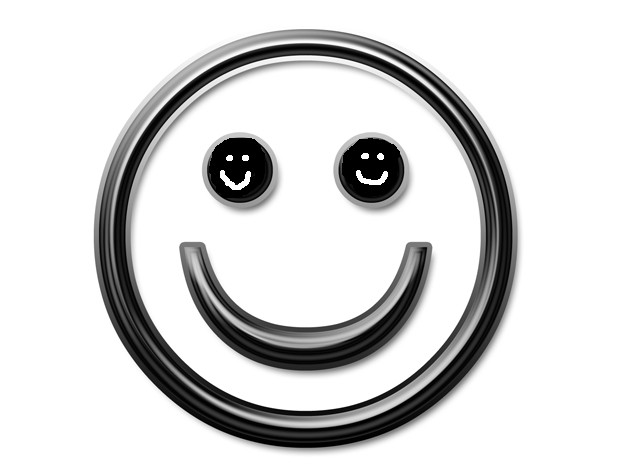Mr. Darcy Might Have LOL’d: On Male Usage of Emoticons and Laugh-cronyms
by Joe Berkowitz

My face is set in a neutral expression as I type this, probably too dull to merit an emoticon. Let’s say I was smiling, though, or even laughing. Let’s say I was laughing so hard that part of my ass literally came off, on account of all the calories expended. You wouldn’t know it unless I mentioned it. Right now I’m conveying meaning through words only — complete, unadorned sentences. In other words, I’m conducting myself in the manner apparently most befitting a man.
It has increasingly come to my attention that a lot of women consider the male usage of emoticons and LOL to be at best a ‘pet peeve,’ and at worst a ‘total dealbreaker.’ As someone who takes a spirited interest in the evolution of language, and conducts feverish, Talmudic research into what women find objectionable, I thought the matter could use some further scrutiny. What exactly is the problem here, and how bad is it?
First off, allow me to briefly distance myself from the behavior in question: I’m not much of a LOL-er, and I do 80% of my emoting with my actual face. While it’s polite to acknowledge when the person you’re texting with has made a humor-joke, I prefer to use the simple “haha,” rather than the stage-directiony LOL. As far as the declarative-sentence LOL goes, well, telegraphing the fact that you find what you’re saying to be funny seems at least as pointless as explaining to James Bond that you’re going to kill him, rather than just offing the bastard straightaway.
These qualms of mine are far outmatched by the nose-wrinkling vitriol with which ladyfriend after ladyfriend has condemned the textual flourishes of the men in their lives lately. I haven’t heard this much shared female disapproval since the early days of the deep-V renaissance. Online, this scorn is echoed by plenty of Facebook groups and Yahoo Answers pages devoted to getting guys to stop LOL-ing and :)-ing. And not that I have any idea what an online dating profile looks like, but let’s just say that a lot of online dating profiles also wax apocalyptic about this issue. Why?
Maybe it’s a masculinity problem; Adam Carolla’s forecasted conspiracy coming true. Clearly a stoic Don Draper-type would speak exclusively in eloquent, fluid sentences and never resort to emoticons. The problem with this scenario, though, is that, like many other symbols of traditional masculinity, Don Draper exists forever in the golden age before G-chat. Considering the fact that our social traits are forever being refined by technology, who knows how our masculinity standard-bearers would act today? Mr. Darcy’s letters to Elizabeth Bennett might read differently if they were sent from a Blackberry Storm instead of a quill. Let’s face it, Darcy might have LOL’d. (He would’ve definitely “haha”d, at the very least.) Judging the men of today based on outdated standards is a slippery slope.
If it all boils down to manliness, though, then it’s kind of insulting. Not toward me and my brethren, but for women. Linking LOL and the smiley to a lack of testosterone implies that anything written with less than Comp 101 formalism is automatically “girly.” Obviously, that’s an insane argument to make. It’s not as though dropping an LOL is in the same inherently feminine league as writing squee or using an angle bracket and 3 to make a love-heart. In all likelihood, the real problem with emoticons and LOL-ing isn’t that they make men seem girly, but that, when overused, they make us seem like tools.
Perhaps men don’t need to go into total emoticon abstinence, but just to avoid specific textual abuses. For instance, sarcasm is some famously rocky terrain to traverse in text form; therefore, sarcasm-enhancing emoticons should be allowed. On the opposite tip, all symbols deviating from the smiley/winky/frowny triumvirate are probably too elaborate and therefore deserve whatever turnoff factor they incur. Ultimately, the user should be judged on a case-by-case basis rather than summarily dismissed.
As for LOL, it was recently officially recognized in an update of the Oxford English Dictionary, along with OMG and other initialisms. According to the announcement, “The intention is usually to signal an informal, gossipy mode of expression, and perhaps parody the level of unreflective enthusiasm or overstatement that can sometimes appear in online discourse.” The mention of parody here is significant. If a large chunk of total usage is devoted to satirizing sincere usage, then any random utterance should be given a pass. Time will out the person who punctuates every other sentence with LOL, and it’s only with high-frequency that these letters should be met with gender-blind scorn.
Oddly enough, the only context in which many of my dude-friends claimed to use LOL and emoticons when I asked was in the service of trying to hook up. Either they’re total bald-faced liars, though, or forgetful as goldfish, because lots of guys do use these things with each other fairly regularly. Sometimes it’s to soften an urgent demand (“Get the fuck over here, lol”); other times it’s to cap off a punchline (“‘You’re the man now, dawg’ –Sean Connery :)”.) Either way, for better or worse, these items are indelibly etched into the male lexicon. They can be limited, but probably not eliminated.
Besides, it’s not like there aren’t plenty of bigger fish to fry — we have yet to see the full extent of repercussions related to the ongoing #swag crisis.
Joe Berkowitz edits books and writes stuff. He also has a Tumblr.